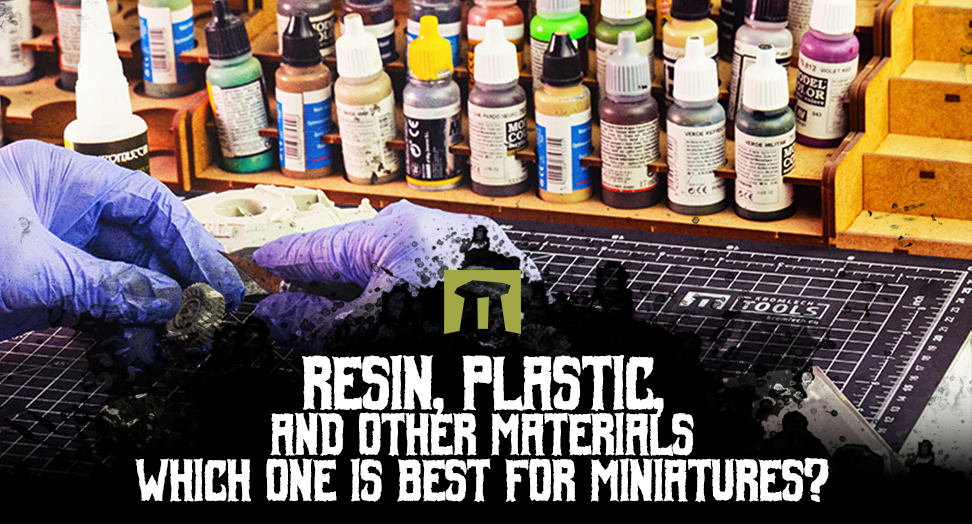Resin, plastic, and other materials - which one is best for miniatures?

In wargames, miniatures can come not only in various shapes and sizes but made from different materials as well. Whether it’s because of production costs, a specific style of a certain Tabletop Game, tradition, or producers/clients' preferences, during your hobbyist career, you’ll undoubtedly see a variety of miniatures made from several materials. Worth underlining - some of them may originate from the same system! Truth be told, this happens a lot. So if you ever asked yourself “What material should I get miniatures in?” you arrived at the right place.
Comparing resin, plastic, and other materials
It may sound a bit obvious, but every material has advantages and disadvantages. Remember that, ultimately, it’s up to you which miniatures, bits, etc. you’ll collect. Sometimes, something can be enormously better than something else for one, and - simultaneously - for others, it’ll be the other way around.
In the beginning, it’s a crucial thing to say that sometimes materials aren’t even. Resin in one place may not be as good as resin in another place. In this article, we’ll compare only those variants of plastic, metal, and resin which can be best described as “high-quality.” All to make this comparison as fair as possible.
Plastic miniatures are rich in detail and pretty straightforward to handle. Gluing and converting them shouldn’t be a significant challenge, although it’s good to remember that plastic isn’t durable. Thin parts made from this material are very liable to crushing and breaking, and it might be challenging to repair them to the level it won’t be noticeable.
Metal is the heaviest and most durable material of all three, which are the subjects of this comparison. Unfortunately, these features come with a price, and we’re not necessarily talking about money. Metal models aren’t as detailed as those made from the other two materials. Nowadays, it isn’t common to produce miniatures from metal - it was popular some time ago, so many older figures and bits were made from this material.
Resin miniatures can be as highly detailed as plastic ones. They need a little different handling and are more or less the same when it comes to durability. They're - however - a little "better" if we talk about the conversion process. Although it’s an always applicable rule to be careful when cutting resin with a hobby knife or gluing, this material might be more forgiving than plastic and, in conclusion, easier to repair.

Wargaming bits can be made from different materials and produced in various ways.
How to find the best material for your miniatures
Finding the best material for miniatures might be difficult because - as we stated earlier - it’s highly dependable on individual preferences. What is far less confusing is finding the best version of certain material. As with many things, in that case, the easiest way of getting to know that is by giving it a try by yourself. Of course, different producers are specializing in making models from various materials. We - at Kromlech - are making the majority of our products from resin, and we can assure you that it’s the best resin for miniatures that you can find!
Resin can offer your modeling collection a lot - not only miniatures but, for example, resin bases for those miniatures. They’re a comfortable solution, as they can be designed to fit the miniature perfectly - including scenery, etc. Such resin miniature bases are often part of a set that also includes the miniature itself.
Most commonly used materials for miniatures
The miniature basing material is significant, but remember that you don’t need to limit yourself to only one, even if - in your opinion - it’s “the best miniature material.” Don’t forget that plastic and resin are more commonly used nowadays than metal. Luckily, there is no need to possess only one material collection, and you can freely mix different types of it.
The statement above is especially true when you remember what naturally comes after collecting the miniatures, and that is painting them. Once you paint all your models, it’ll be almost impossible to tell which ones are made of what unless someone grabs them. Worry not! The material doesn’t have a significant impact on covering miniatures with paint, if you remember about such tricks like base coat, lacquer, etc. With those, you can calmly use any effects, such as realistic weathering effects on miniatures made from any material.
And one more thing to remember - not every wargaming stuff will be made from the same material as miniatures. See by yourself while modeling and basing them - you’ll discover many different types of material that can be used to finish your models or upgrade their looks - and even further when you’ll be gathering gaming accessories ahead of your wargaming battle!




